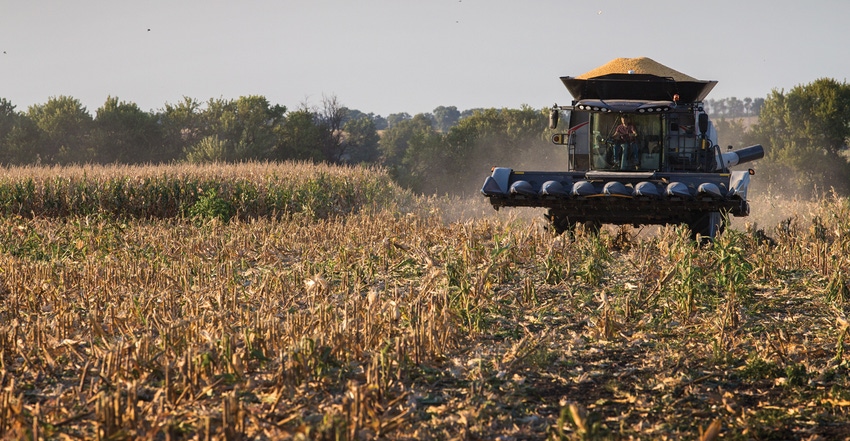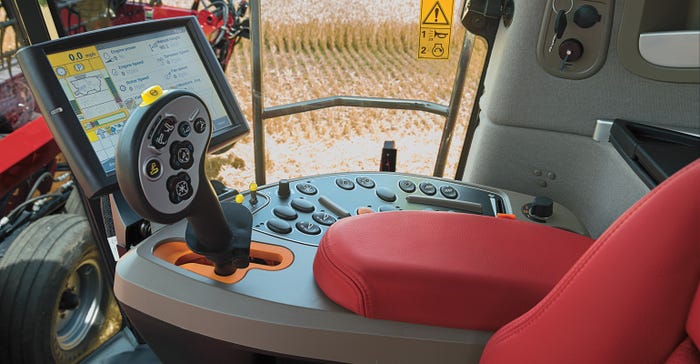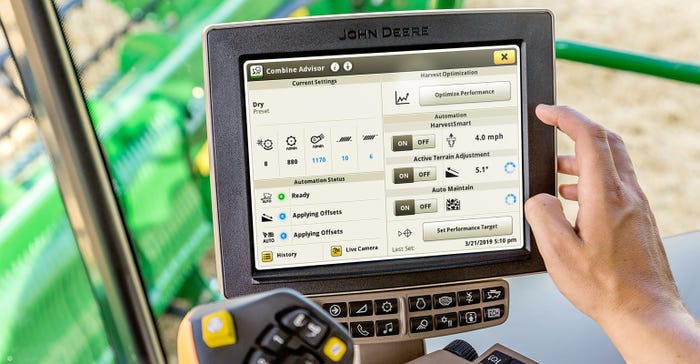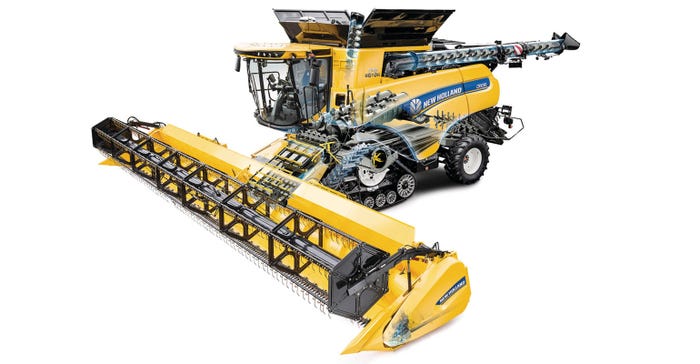
There are farmers who harvest some high-moisture corn every year. For most, though, it may have been a while since you harvested corn in the 24% to 28% range. Agronomists say that could be reality this year. How do you harvest effectively under those conditions?
“This is going to be a year when you need to be ready,” says Kelly Kravig, Case IH harvesting marketing manager. “Pull the manual out and become more familiar with your machine and settings.
“Then, before you start, pull a couple ears. Is it ready to harvest? What is cob integrity like? What adjustments will you likely need to make?”
Maybe the biggest thing you can do is be patient, he adds. “Take a deep breath and prepare to slow down,” he says. “That applies to both you and your combine speed!”
Matt Badding, marketing manager for combines and headers for John Deere, agrees that the operator’s manual is a great place to start, no matter which color or what age of machine you’re preparing for fall. “All the settings you’re going to need will be there,” he notes. “Your brand may have other tools which provide settings and information, but you still want to get familiar with your operator’s manual.”
Details and more details
Farm Progress invited makers of several major brands of combines to share specific tips for getting their combines ready for fall 2019. Each representative was asked questions related to harvest. Those providing information include: Zach Stejskal, combine marketing specialist for Agco Gleaner; Kravig for Case IH; Jeff Gray, product manager and field support specialist for Claas Lexion combines; Badding for John Deere; and J. Cole Sanford, cash crop product specialist for the northeast region for New Holland Agriculture.
What major adjustments are needed on your machine when corn is 24% to 28% moisture to maximize yield, yet have clean grain?
Agco Gleaner: There are three steps operators should take to address this harvesting condition. The first two are in relation to shoe load since high-moisture corn and high-yielding corn present large amounts of volume direct to the shoe. Our first suggested action is to open your bottom sieve to the widest clearance or take it out altogether. The next step would be to utilize a high-capacity top chaffer designed for high-moisture conditions. Finally, ground speed can be controlled to mitigate any further losses.
Case IH: We consider high-moisture corn anything 22% or higher. Cob integrity is the key. You want a cob firm enough for the machine to take kernels off without breaking the cob into pieces. If cobs are spongy, it’s much more difficult to thresh kernels.
In high-moisture corn, the best place to start is with what we call harvest presets for rotor speed, concave clearance, fan speed and sieve settings. If you start there, then you can adjust any one of them as necessary. If you find the machine works best at different rotor and concave settings, once you have them dialed in, you can save and name that bank of settings as another preset. For example, if a certain hybrid threshes best at certain settings, save them so that if you harvest that hybrid again, you can return to it.
Most of our machines are equipped with large wires on the concave upfront and skip wires on the rear. In high-moisture corn, you may want to switch out two or three large wires for round bar concaves upfront to thresh off high-moisture kernels more easily. Round bar concaves should be readily available at your dealer.
For the Case IH 250 Series, we also offer AFS Harvest Command as an option. It allows the machine to adjust on the go to optimize performance.

USE YOUR TOOLS: You have various tools at your disposal in the form of settings you can adjust, says Kelly Kravig, Case IH. Get more familiar with your owner’s manual and tools in the cab, he suggests.

Claas Lexion: One key advantage of a Lexion combine is threshing and separation systems speed is adjusted separately. This enables greater flexibility to adapt to changing conditions more efficiently to prevent overthreshing while optimizing separation for maximum grain retention.
When setting a Lexion combine for threshing, set concave according to cob diameter and adjust in 1- to 2-millimeter increments to minimize potential for damage. If you’re using round bar concaves, set it at cob diameter to 3 mm over cob diameter. For large wire concaves, set at 3 mm over cob diameter. Increase threshing speed, starting around 360 rpm, in 10-rpm increments to minimize the potential for damage.
For separation, increase speed of the dual separation rotors, starting at 400 rpm, in 10-rpm increments, as needed, to avoid excessive loss.
John Deere: We’ve relied on rotary machines since 1999, so we’ll direct comments toward our rotary machines. Some suggestions also apply to earlier machines. The best advice is to read your operator’s manual.
To harvest high-moisture corn, start by making sure all concave, sieve and chaffer settings are calibrated and zeroed out. Your manual describes the procedure. Calibration is necessary to make sure if a setting is supposed to be at 12, for example, it’s truly at 12 when the display says it is.
Think grain quality first and start at the head. Run the deck plates tight and make sure the auger is in the down position, so it doesn’t scuff high-moisture kernels. We recommend buying and installing smooth wear strips on the feed accelerator, also called the beater.
On the dual-zone chaffer, make sure the rear chaffer is closed. That directs more wind toward the front. The goal is to keep green material afloat and blow it out of the machine.
Note that on S700 Series machines, you can purchase the Combine Advisor option. Using cameras in the tailings and clean grain elevator, it can adjust to maintain quality within a specified range.

AUTOMATIC ADJUSTMENT: Some companies offer options or even factory equipment on newer machines that can adjust to conditions for you. Combine Advisor is an option from John Deere on S700 Series combines that will adjust settings if conditions change.

New Holland: With the New Holland CR Revelation Series Twin Rotor combines equipped with IntelliCruise and IntelliSense, New Holland’s automation features that automatically control combine settings and ground speed, the operator just needs to simply engage the two systems.
Utilizing components of the system — namely the cleaning shoe pressure sensors and the grain camera — the IntelliSense system can determine proper settings. IntelliCruise looks at engine power consumption, header power consumption, rotor loss sensors and cleaning loss sensors to determine a proper ground speed that meets the needs of the operators’ inputs. The unique cleaning shoe pressure sensors can sense the air pressure delta above and below the top sieve, making combine cleaning shoe adjustments before any grain hits the cleaning shoe loss sensors. They act as a cleaning shoe loss “predictor,” enabling the combine to proactively predict shoe losses if they were to occur, and then adjusting combine settings to prevent them from happening.
Dynamic Flow Control, which is New Holland’s remotely adjustable rotor vanes available on the 22-inch twin rotor machine, is the biggest productivity booster when harvesting high-moisture corn. Dynamic Flow Control happens to be one of the first things IntelliSense decides to adjust when losses over the rotors increase — typical of a high-moisture corn harvesting condition. By “slowing down” the vanes or decreasing the angle of eight vanes per rotor to the crop flow, it holds material in the rotors longer, promoting proper threshing and separation in high-moisture corn. The end solution is less losses and a better sample for the grain tank for a given ground speed — all controlled automatically.

UNDERSTAND FUNDAMENTALS: This cutaway image illustrates the basic parts inside a combine. This combine is equipped with a grain head, but you can adjust settings in corn or beans to help the parts work better together in tough conditions. Use the New Holland Harvest Excellence App for settings and as an adjustment guide.

What if corn is 30% moisture or higher? Can you still adjust to handle it?
Agco Gleaner: Harvesting above 30% is problematic and presents uniform challenges for any combine platform. However, adjustments made at the 24% to 28% levels still apply. The operator can adjust ground speed as needed to reduce loss. Gleaner’s platform allows for it to adapt and be forgiving in all conditions, including non-optimum conditions.
Case IH: This puts us right on the edge, but there are a couple of key things when corn is that wet.
First, pay careful attention to settings and instructions in the manual. Second, stop the combine and judge performance. Are you maintaining integrity of the ears? You want to see whole cobs come out the back. If you have broken cobs or split ears, maybe concave clearance is too tight or too wide.
Before you start in these conditions, pull a couple ears and check cob diameter. That’s the distance you want between the tip of the rasp bar and the concave. The manual can walk you through it. Go back to fundamentals.
Claas Lexion: Certainly, continue increasing threshing speed in 10-rpm increments. The concave gap may need opening to compensate. If so, always adjust in 1- to 2-mm increments until the optimal setting is reached.
In higher-moisture corn conditions brought on by frost, there’s a greater possibility for softer cobs which can break more easily and challenge threshing performance. Therefore, it’s critical to set the concave according to cob diameter to keep cob damage to a minimum for greater threshing efficiency.
John Deere: Our recommendations don’t change that much for corn above 25% moisture. However, if you’re at 30% or above, I recommend doing a “power shutdown” to inspect performance. When the combine is fully loaded going through the field, reach over and stop the separator; then stop the machine quickly. In other words, kill the combine loaded with crop. Sometimes customers look at me funny on this one, but it works. I’ve yet to plug one.
It gives you an instant look at performance. Take apart the side shield and pull out ears between the rotor and concave. Look at the cob — are all kernels off? Are there signs of compression on cobs? They should remain intact, but if you break them in half, there should be signs of compression. Is the rotor going fast enough to separate material and hold down losses?
Check for losses all around the machine. Check before the head and behind the head. Sometimes it’s too easy to blame losses on threshing when some of it happens at the head.
New Holland: Yes. We offer a unique set of concaves referred to as “fishbone concaves,” which are like a common round bar concave with a key difference. Instead of being parallel to the rotor axis, bars are angled/spiraled following crop flow, like fishbones. This enables a self-cleaning action as material travels the distance of the threshing concave, enabling excellent grain-on-grain threshing, and allows wet corn to exit the concaves uninhibited. When the concaves aren’t plugged due to this self-cleaning action, they’re free to allow grain to exit, promoting higher throughput and a cleaner sample.
About the Author(s)
You May Also Like




